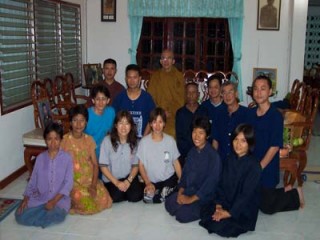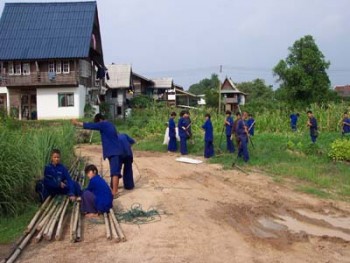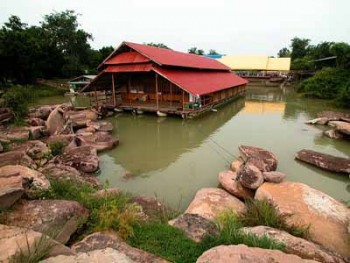Submitted by zhenliang on

(Final Part)
The bus was equipped with comfortable seats and food was provided during the journey. By the time we arrived at our destination, it was only 4.30am . A devotee of Ven. Jin Xiang came to fetch us. He was a policeman, but after he joined the Asoke community, he began to observe the five precepts and became a vegetarian. He then opened a small shop for his wife to sell the organic products of Asoke village and after a few years, his shop became the biggest in the town. His house was also very beautiful for their standard of living. He was a very devoted member of the Asoke community, holding strong to his five precepts, and serving the community as a policeman. He told us frankly that he was also facing a lot of difficulties in the police academy with his strong adherence to the precepts, and being a vegetarian. However, he was very proud and happy to be a real Buddhist practitioner.
He also shared with us a good family practice, which I think was what made his family life blissful. He was staying with his wife who was pregnant. They were already blessed with a son who was attending school in Sisa-Asoke (and staying there). His parent-in-laws, who were both Asoke followers, and his own mother were staying with him. Everyday they would sit down together for dinner and after dinner, they would share with each other their experiences of the day and the problems they faced in practicing the Dharma during the day. Then the others will give their opinions and encouraged each other to improve on the Buddha's path. This is what we could really call a Buddhist family. They really put practicing of the Dharma in the family. Instead of sitting down to meditate, which is an individual cultivation, sitting down in a family circle to review the daily life, the extent of each family member's cultivation, and be each others' Kalyana Mitra, encourages everyone to develop further, together.
In the Asoke community, they have their own standard of checking their own progress. They believe that everyone can be an Arahant, and if you could uphold the five precepts to the fullest, you are already an Arahant on the first stage (cu guo). This is followed by fully observing the eight precepts (which many of the villagers were doing) leading to the 2nd stage of Arahantship (er guo), and the upholding of the ten precepts leading to the third stage (san guo). For those who become a Bhikku or Bhikkuni and upkeep the precepts to the fullest, they could be an Arahant. The important thing is to keep the precepts and cut down the desires step by step, till there is no desire, leading to the attainment of Nirvana.
That day we also visited the Asoke Museum in the Sisa Asoke village. It was set up by Ven. Jin Xiang. Fu Bao had also published about it in the latest issue. We managed to visit a few organic "food and vegetarian orchards". They were like the jungle, covered with weed. The fruits were so tasty though and you could just pluck any of the vegetables to put in your mouth without worrying about toxins from pesticides. We ate lots of rambutan that evening. That night we were treated to the local Thai vegetarian Tom Yam and other local food by the policeman family.
The next morning, we went to visit one of the ancient cities (something like Angkor Wat, but in a much smaller scale) in the Thai-Cambodia border. The place originally belonged to Thailand , but the French took possession of it when they ruled Cambodia . The border people could cross the border by paying 50 baht, so we pretended to be Thais in order to cross over. One of the Cambodian officers came to us and asked us some questions in Thai. We couldn't understand him. Luckily Bro. Maha came to our rescue.
The place was very beautiful, but not well maintained. The Cambodian kids would follow the tourists from the starting point till we reached the top, then came down with us, hoping that we would buy post cards or water from them. A small kid cried when we refused to buy anything from her, but her cries turned to smiles when Bro. Maha gave her a piece of bread. According to her, she had to go up and down at least five times a day; the poor kids! The building was on the hilltop, and the scenery was very beautiful. With a cool wind, the place was idyllic!
After that, we went to visit Ajahn Chah's place, which was a local as well as an international cultivation forest. High walls surrounded the temples and the public could only access a certain area. This kept the cultivation places secluded for the monks and practicing lay people. However, we were allowed to tour the whole place. Ven. Jin Xiang shared with us a lot on the development and current situation of Thai Buddhism. I learned a lot from this.
Then we went to another Asoke village - Ratchatani Asoke. This is the village that would be flooded for at least one to four months every year. They maintained a lot of big boats in preparation for the flood. There, we saw the biggest building among the Santi Asoke community. This place would be developed into the administrative centre of Asoke in the near future, hence the big building. Imagine the wisdom of Ven. Bodhirak. He would change the most difficult place into a place where everyone wanted to be. One of the villagers told us that it was a good place and they would get a new house every year due to the flood! Every time when it flooded, the other villages would send food and other stuff for the villagers, and have a celebration of sorts with games, performances, etc.
I was amazed at how the "problem was turned into wisdom" (fan nao bian pu ti). They didn't blame the weather. Instead they looked forward to it because it became a challenge for them to train themselves and to practice "letting go", since everything would be swept away by the floodwaters. There, we also saw how man could live in harmony with nature and her destructive forces.
That night, we set off for Bangkok and the journey back to Malaysia the next day.
We arrived at Bangkok early the next morning, at about 5am . We then proceeded to our rest station - Shanti Lodge (If you happened to be in Bangkok , this is a good budget hotel to stay in). This rest house is a four-storey building, with rooms ranging from RM10 to RM60 per night. Also, a great benefit to us was that it provided vegetarian food! One of the managers there was a devotee of Ven. Jin Xiang, who offered dana to Venerable. We were also served with delicious food which were all free of charge.
After a short rest and breakfast, we then proceed to another interesting sight in Bangkok – the Sathira-dhammasathan Temple . It is a garden temple in Bangkok city; a place to clear all your worldly stress. Once you stepped within the boundaries of the temple, you could feel serenity and calmness filling your heart. There we saw a few of the sacred Buddha's relics, and gave lotus flowers as offerings. Massage services were also provided, as a way of collecting donations for the temple.
We then hurried back to pack the many trinkets and souvenirs which we had bought, and barely managed to reach the airport in time. After checking, we took the 3.15pm ( Thailand time) flight back to Malaysia , reaching KLIA about 6.45pm ( Malaysia time).
To me, this was a very memorable and eye-opening trip. I have seen and contemplated a lot; how the people of Asoke put the Dhamma into their daily life practice, maintaining their precepts, and lessening their desires, giving them a happy and contented life. They are like people living in the Pure Land , except this Pure Land is still within the boundaries of Samsara. All of their basic needs are provided, and they are happy workers, with the Dhamma as their guide.
The most important thing though, was that everyone in the community was a Kalyana Mitra to others. They have no need to close their eyes and meditate, for they live mindfully and peacefully. Unlike us, they do not need to take 7 days leave just to join a retreat, or keep themselves away from others, for their cultivation is in their daily life practice. To them, to cultivate is to constantly be mindful, by cutting down all their desires. They are always striving to attain a higher stage in life, and it has proven to be achievable, through mindful daily practice.
Visits to various sacred temples like the Ji Xiang Dao, Ajahn Chah, and also Sathira-dhammasathan was also very inspiring. The effort and hard work poured in to build a cultivation place for all sentient beings, for it is a place to offer everything including your own life to the Buddha Dhamma. There is no selfishness, only love for all beings. The great masters are like the Bodhisattvas who transformed themselves into various forms to guide and teach us - beings who are still suffering within the Samsaric cycle. As I reflect back on my life, I had many ‘ripe' conditions, also known as "yin yuan", but still I did not take the initiative to practice what was freely given to me.
I would like to express my gratitude to Ven. Jin Xiang and Bro.Maha, who had made good arrangements to ensure a smooth and worthwhile trip, and also to our group members, for their care and support throughout the journey. Also, I am very grateful to all that we have met during the trip, for they have enriched my life, and made this trip a beneficial and fruitful one. I would also like to transfer the merits that I have gathered to all sentient beings; may they always follow the Buddha's path, and be reborn in the Pure Land .
Amituofo.



